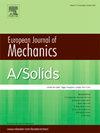用于变截面双向功能梯度梁弯曲分析的傅立叶神经算子
IF 4.2
2区 工程技术
Q1 MECHANICS
引用次数: 0
摘要
近年来,神经算子在求解参数偏微分方程(PDEs)方面显示出巨大的潜力。然而,它们的训练过程需要一个大的标记输入输出数据集,这在工程建模中计算成本很高。因此,放弃这一要求的具有物理学知识的神经算子引起了极大的关注。在这项工作中,提出了一种物理通知的傅立叶神经算子(PIFNO),用于具有可变截面的双向功能梯度(BDFG)梁的弯曲分析。将该问题表述为一个变系数边值问题。这些系数包括材料和几何特性,而梁的响应是根据横向位移和弯矩来测量的。PIFNO的设计是在给定系数(输入)的情况下预测光束的响应(输出)。基于欧拉-伯努利梁理论,输入用挠曲刚度表征,输出用傅立叶神经算子(FNO)逼近。在PIFNO中,引入了控制方程的无量纲形式和性质标度。此外,输出与边界条件相结合,产生自动满足这些条件的新输出。用有限差分法(FDM)定义损失函数。数值算例研究了多种边界条件下不同类型的材料分布和不同形式的变截面。结果表明,在不需要标记输入输出数据集的情况下,PIFNO可以准确地预测各种边界条件下的位移和弯矩。本文章由计算机程序翻译,如有差异,请以英文原文为准。
Physics-informed Fourier neural operator for the bending analysis of bi-directional functionally graded beams with variable cross-sections
Neural operators have recently shown great potential for solving parametric partial differential equations (PDEs). However, their training process requires a large labeled input–output dataset, which is computationally expensive in engineering modeling. Consequently, physics-informed neural operators, which forego that requirement, have attracted significant attention. In this work, a physics-informed Fourier neural operator (PIFNO) is proposed for the bending analysis of bi-directional functionally graded (BDFG) beams with variable cross-sections. The problem is formulated as a boundary value problem with variable coefficients. These coefficients include the material and geometrical properties, while the beam response is measured in terms of transverse displacement and bending moment. PIFNO is designed to predict the beam’s response (output) given the coefficients (input). The input is characterized by the flexural stiffness, based on Euler–Bernoulli beam theory, and the output is approximated by a Fourier neural operator (FNO). In PIFNO, a non-dimensional form of the governing equations is introduced along with property scaling. Furthermore, the output is combined with boundary conditions to produce a new output that automatically satisfies these conditions. The loss function is defined using the finite difference method (FDM). Numerical examples examine various types of material distributions and different forms of variable cross-sections under multiple boundary conditions. The results show that PIFNO can accurately predict the displacement and bending moment for various boundary conditions without requiring a labeled input–output dataset.
求助全文
通过发布文献求助,成功后即可免费获取论文全文。
去求助
来源期刊
CiteScore
7.00
自引率
7.30%
发文量
275
审稿时长
48 days
期刊介绍:
The European Journal of Mechanics endash; A/Solids continues to publish articles in English in all areas of Solid Mechanics from the physical and mathematical basis to materials engineering, technological applications and methods of modern computational mechanics, both pure and applied research.

 求助内容:
求助内容: 应助结果提醒方式:
应助结果提醒方式:


